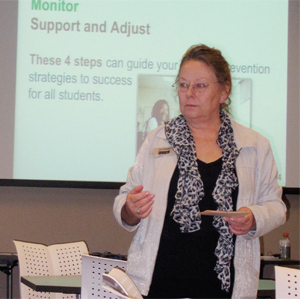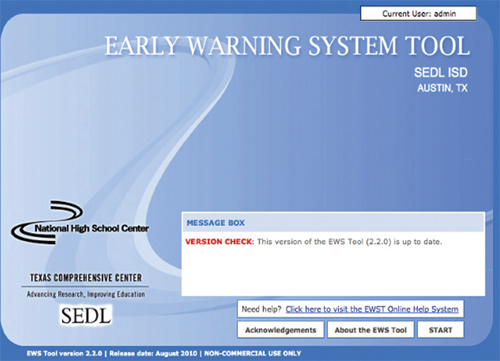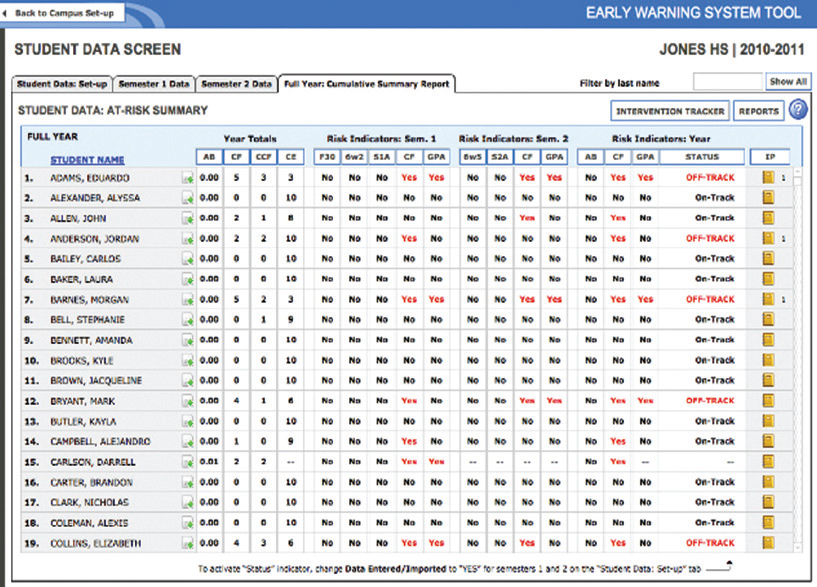Reading the Warning Signs - Using Research to Prevent High School Dropouts in Texas

Every school day, nearly 7,000 students across the United States leave school without a diploma and never return, amounting to 1.2 million dropouts annually (Wise, 2008). The impact of dropping out is severe—on both the individual and society. Over the course of a lifetime, a male high school dropout will earn approximately $322,000 less than a male high school graduate and approximately $1.3 million less than a male college graduate. Moreover, a high school dropout is more likely to commit crimes, rely on government health care, or use public services such as food stamps or housing assistance (Monrad, 2007). Although the dropout challenge is not new, many of the solutions educators are using are. In Texas, SEDL’s Texas Comprehensive Center (TXCC), in collaboration with the National High School Center (NHSC) and the Texas Education Agency (TEA), is showing educators how to use data and technology to keep students on track for graduation.
Early Warning Signs
The dropout prevention resource that Texas educators are using is the Early Warning System (EWS) Tool, developed by American Institutes for Research (AIR) for the NHSC and customized for Texas by the TXCC. The EWS Tool is an application that tracks student data and, based on specific indicators, flags students who are at risk of dropping out. Researchers have identified ninth grade as a decisive year in a student’s academic career, with attendance and course performance being most predictive of whether a student is at risk of dropping out (Allensworth & Easton, 2005, 2007; Balfanz & Herzog, 2005; Neild & Balfanz, 2006). If a student meets certain benchmarks for these “high-yield” indicators, as they are known, he or she is considered off track for graduation. For example, a student’s absenteeism rate—specifically, the number of days absent during the first 20 days, each quarter, and the first year of high school—provides information about whether he or she is likely to stay in school. A student who misses more than 10% of instructional time during the first year of high school is considered off track (Allensworth & Easton, 2007; Heppen & Therriault, 2008).
In the area of course performance, researchers highlight course failures and grade point average (GPA) as areas to monitor, stressing that even one failed course or a GPA under 2.0 is a red flag. Combining these two indicators, two or more Fs in core academic courses or fewer than one-fourth of the credits necessary for graduation is a sign that a student is off track for graduation, or at risk of dropping out (Allensworth & Easton, 2005; Kennelly & Monrad, 2007). Based on the combination of indicators, students who were on track at the end of their freshman year were four times more likely to graduate than their classmates who were not on track (Allensworth & Easton, 2007).
Educators across the United States have been using the NHSC’s EWS Tool to bridge the gap between research and practice. The tool tracks attendance and course performance—those high-yield predictors of dropping out that researchers have identified—and flags students who have reached a specific benchmark in these areas. “It was really obvious to us that the research out there was very clear and very comprehensive, . . . but there was a need for somebody to help translate that research into practice,” says Mindee O’Cummings, an AIR senior research analyst and technical assistance liaison with the NHSC. The tool, which was released in version 2.0 in Fall 2010, also helps staff at the district and school level identify and focus on the same objectives. “One of the biggest problems in high school is that there’s a lot of good stuff going on and a lot of positive pockets, but it very seldom is aligned and cuts across multiple programs,” notes Joseph Harris, director of the NHSC and managing research analyst at AIR. “With the introduction of an early warning system based on the tool, everybody’s focusing on the same thing at the same time.”
Made for Texas
In Texas, a state with more than 1,200 school districts and myriad data-management systems, education leaders wanted to deploy the EWS Tool in a variety of settings. They looked to the TXCC to make this possible. “The original prototype that the High School Center developed was an Excel spreadsheet,” explains Chris Caesar, a program manager with the TEA’s Division of Dropout Prevention and College and Career Readiness Initiatives. “The Texas Comprehensive Center folks turned it into a database, which has a bit more functionality and features on it.” In addition to the high-yield indicators, the Texas version tracks some secondary indicators like disengagement and failure to be promoted to the next grade. “User feedback has shaped some of the updates we have made to the tool. The most recent version allows users to create graphs and record intervention data,” says Eric Waters, a SEDL database development associate, who oversaw the creation of the desktop version of the tool originally developed by AIR and the NHSC.

Ann Neeley shows Texas educators how to use student data to identify and provide support for students who are at risk of dropping out of school.
The TXCC and TEA are providing user support for the database as well as professional development on implementing research-based interventions for students who are identified as being off track. “Tutoring, eighth-to-ninth-grade transition programs, these interventions can be effective or ineffective, depending on how you implement them,” says Ann Neeley, a SEDL program associate who works with the TXCC. The team stresses the DIVA approach: using data, identifying a research-based intervention, verifying that the intervention is successful, and adjusting it if necessary.
Some of the Texas educators who have invested time and effort into mastering the tool are pleased with the results. “We have experienced a large increase in the percentage of ninth grade students who pass their classes,” reports Lorena Molinar, a counselor at Fort Hancock High School in Fort Hancock, Texas. “Last year 67% [of freshmen passed], and this year 87% have.” Although the tool alone did not boost student achievement, it helped educators at Fort Hancock identify which students were at risk. “Now, when they look at the data, [teachers] can instantly see who needs help,” Molinar explains.
Like the tools’ developers, Caesar sees the database as a way to help educators implement research about dropout prevention. “We don’t need to send a principal down a rabbit hole, reading articles, because we’re basing our programs on research and connecting them to specific strategies.” He also sees the ongoing collaboration as key. “I view our work with the Texas Comprehensive Center and the National High School Center very much as an innovative example of the kind of collaboration that can really help districts, . . . not just with the technical stuff, but to connect that technical assistance to programmatic interventions and strategies.”
Bibliography
- Allensworth, E., & Easton, J. Q. (2005). The on-track indicator as a predictor of high school graduation. Chicago, IL: Consortium on Chicago School Research.
- Allensworth, E., & Easton, J. Q. (2007). What matters for staying on-track and graduating in Chicago Public High Schools: A close look at course grades, failures, and attendance in the freshman year. Chicago, IL: Consortium on Chicago School Research.
- Balfanz, R., & Herzog, L. (2005). Keeping middle grades students on-track to graduation: Initial analysis and implications. Presentation at the second Regional Middle Grades Symposium, Philadelphia.
- Heppen, J. B., & Therriault, S. B. (2008). Developing early warning systems to identify potential high school dropouts. Washington, DC: National High School Center.
- Kennelly, L., & Monrad, M. (2007). Approaches to dropout prevention: Heeding early warning signs with appropriate interventions. Washington, DC: National High School Center.
- Monrad, M. (2007). High school dropout: A quick stats fact sheet. Washington, DC: National High School Center.
- Neild, R. C., & Balfanz, R. (2006). Unfulfilled promises: The dimensions and characteristics of Philadelphia’s dropout crisis, 2000–2005. Baltimore, MD: Johns Hopkins University, Center for Social Organization of Schools. Retrieved from http://www.every1graduates.org/PDFs/ Unfulfilled_Promise_Project_U-turn.pdf
- Wise, B. (2008). Raising the grade: How high school reform can save our youth and our nation. Hoboken, NJ: Jossey-Bass.
Next Article: Knowledge for a Better Life: Ensuring Research Benefits People With Disabilities



